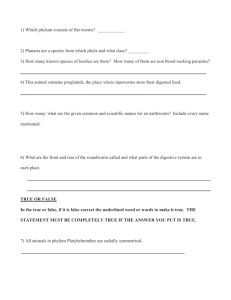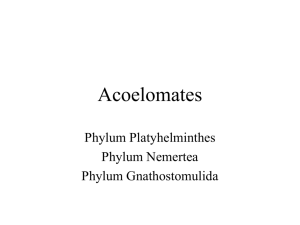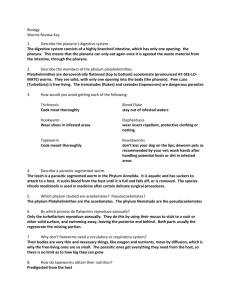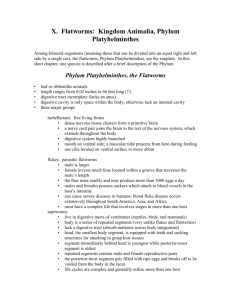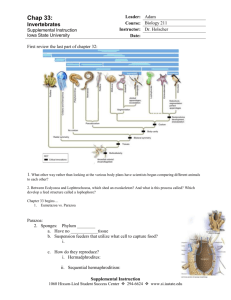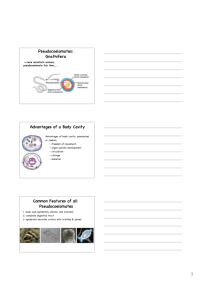Platyhelminthes
advertisement
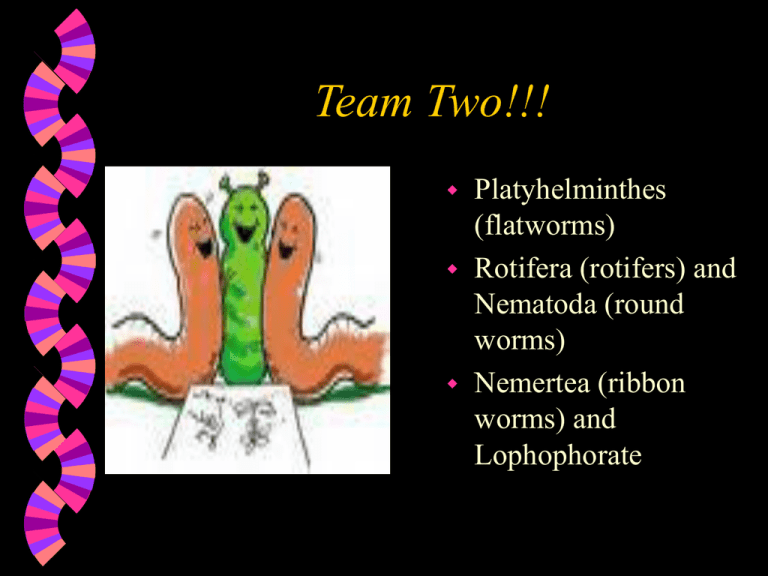
Team Two!!! Platyhelminthes (flatworms) Rotifera (rotifers) and Nematoda (round worms) Nemertea (ribbon worms) and Lophophorate Platyhelminthes Have bilateral symmetry Can be free living or parasitic which absorb nutrients from a host Have 3 germ layers and are acoelmate (lacking a cavity between gut and outer wall) Are protostomes Move by using cilia or by contracting their muscles Flatworm Platyhelminthes Tapeworm Free living platyhelminthesreproduce asexually by fission and parasitic platyhelminthes reproduce sexually and self fertilize The embryo of tapeworms and other parasitic worms are called scolex Platyhelminthes Schistosoma Life Cycle- -Trichinella Life cycle Platyhelminthes Specalized Tissues Platyhelminthes have a ventral nerve cord • have eye spots that detect the intensity of light • have ganglia, which is a mass of nerve cell bodies ( resembles a brain) • have a gastrovascular cavity called a pharynx- which is a single opening used as both a mouth and anus Examples are tapeworms, flukes, Dugesia, Dugesia tigrina Phylum Rotifera About 1,800 species Are tiny animals that mainly inhabit fresh water, although some live in the sea or in damp soil. Range in size from about 0.05 to 2 mm (much smaller compared to other protists.) Have bilateral symmetry and are truly multicellular. “Rotifer,” derived from Latin, means “wheel-bearer”—a reference to the crown cilia that draws a vortex of water into the mouth. Examples: Rotaria, Philodina, Keratella, Brachionus, and Polyarthra. Phylum Rotifera Have specialized organ systems—including a complete digestive tract: a digestive tube with a separate mouth and anus. Perform a type of reproduction called parthenogenesis: females producing more females from unfertilized eggs. Phylum Rotifera Are pseudocoelomate animals—they have a cavity that is not completely lined by mesoderm-derived tissue. The fluid in the pseudocoelom serves as a hydrostatic skeleton and as a medium for the internal transport of nutrients and waste. Rotifers may be: -free swimming -able to move by inchworming along the substrates -sessile, living inside tubes or gelatinous holdfasts. Video: http://www.youtube.com/watch?v=YF8OJt_pujc Phylum Nematoda Roundworms About 90,000 known species. Many are free-living soil dwellers that help decompose and recycle nutrients. Have bilateral symmetry. Examples: whipworms, hookworms, pinworms, ascarids, and filarids. Nematoda Phylum Nematoda Have a complete digestive tract: a digestive tube with a separate mouth and anus. Covered by a tough, transparent cuticle—the exoskeleton of an arthropod, consisting of layers of protein and chitin. The muscles of nematodes are all longitudinal, and their contraction produces a thrashing motion. This and the cuticle help nematodas to move. Are pseudocoelomate animals— they have a cavity that is not completely lined by mesodermderived tissue. Phylum Nematoda Reproduction is usually sexual—females are generally larger than males. Fertilization is internal, and a female can deposit 100,000 or more fertilized eggs per day. The zygotes of most species are resistant cells capable of living in harsh conditions. Hookworm Phylum Rotifera and Nematoda Are both eumetazoa—they have closely functioning cells organized into tissues. They are triploblastic (contain three germ layers.) These three layers (ectoderm, mesoderm, and endoderm) develop into various organs during embryonic development. There is a progressively greater increase in nerve tissue concentration at the anterior end (head.) Both have a complete digestive tract. Nemertea -The phylum has bilateral symmetry -Has 3 germ layers -Has a primitive coelom. -They use the coelom (filled with fluid) to propel themselves through the water. Many live in water, so they can swim quite well. Has a complete digestive tract and a closed circulatory system. (blood contained in vessels) However, they have no heart, the blood is propelled by muscle squeezing vessels. Baseodiscus delineatus Nemertea (cont.) Life: • As a juvenile the nemertea lives in the exoskeleton of a crab. • The size increases as the crab’s shell increases. • They are predators and will either actively pursue their prey or sit and wait for it. Cerebratulus Nemertea (cont.) Examples: • Malacobdella lives parasitically in molluscs Deep water ribbon worm. Tubulanus rhabdotus The proboscis apparatus is used as a means of catching food. It wraps around the food and draws it in. Nemertea (cont.) Different types of Nemertea have different colors, however their colors change depending on where they are. (caves or exposed). Commonly called ribbon worms. The largest type of Nemertea that has been found, Lineus longissimus, stretched 30 m long! Normally 10mm100cm long. Removal of Guinea Worm http://www.youtube.com/watch?v=mUz9gqLmyQ0 Lophophorate Bryozoan Combines three phyla: Bryozoans, Phoronids, Brachiopods. All three have a lophophore: a horseshoe-shaped fold of the body that has cilia, surrounding the mouth. The three phyla also share a U-shaped digestive tract and have no head. Lophophorate (cont.) They have true coeloms, lined fully with mesoderm. 3 germ layers. Bryozoans and brachiopods are sessile while phoronids live buried in the sand. Development: • Bryozoans- larval; has radial clevage at first, and then spiral. Placed closer to protostomes, however in embryonic development they resemble deuterostomes. Lophophorate (cont.) Phoronopsis californicaphoronid Phoronis hippocrepia phoronid Costazia costazi, bryozoan Onniella meekiBrachiopod Fresh water Bryozoan with lophophore extended. Lophophorate (cont.) Bryozoans help build reefs Brachiopods, resemble clams. Phoronids- tubedwelling marine worms. Tubes made of chitin! Seem to be either asymmetrical or bilateral. Review Game: Platyhelminthes What type of symmetry do Platyhelminthes have? How do Platyhelminthes move? How do parasitic platyhelminthes reproduce? What is the function of eye spots? Answers: Platyhelminthes What type of symmetry do Platyhelminthes have? Bilateral Symmetry How do Platyhelminthes move? By using cilia or by contracting their muscles. How do parasitic platyhelminthes reproduce? They reproduce sexually and self fertilize. What is the function of eye spots? They detect the intensity of light. Review Game: Rotifera and Nematoda What type of symmetry do the phylum Rotifera and phylum Nematoda share? What is a complete digestive tract? What type of reproduction do Rotifers perform? Which phylum has a hydrostatic skeleton? Answers: Rotifera and Nematoda What type of symmetry do the phylum Rotifera and phylum Nematoda share? Bilateral Symmetry What is a complete digestive tract? A digestive tube with a separate mouth and anus. What type of reproduction do Rotifers perform? Parthenogenesis Which phylum has a hydrostatic skeleton? Rotifera Review Game: Nemertea and Lophophorate What are the three phyla under lophophorate? And what do they look like? What is a proboscis apparatus? Where do nemerteas grow up? What is the function of Bryozoans? Answers: Nemertea and Lophophorate What are the three phyla under lophophorate? Bryozoans, Phoronids, Brachiopods And what do they look like? All three have a lophophore. What is a proboscis apparatus? It is used as a means of catching food. It wraps around the food and draws it in. Where do nemerteas grow up? In the exoskeleton of a crab. What is the function of Bryozoans? They help build reefs. ~THE END~
